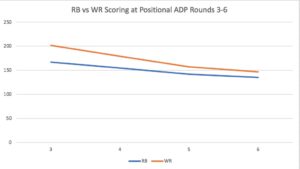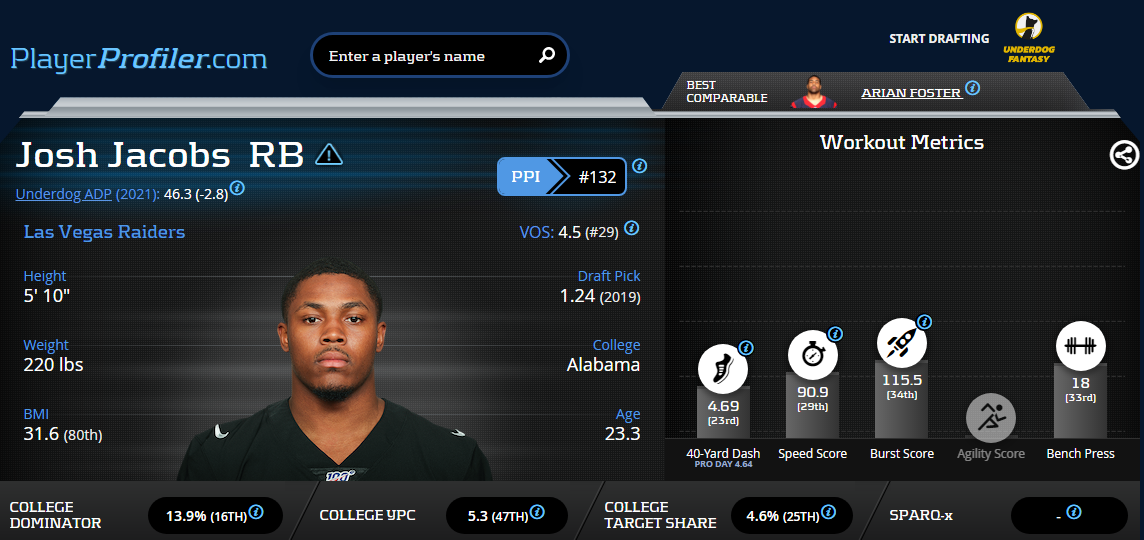Sometimes you should give in to fear.
Eight-percent of Americans are confident they could win a fight with a lion. If one sought my counsel, I would encourage them to be more fearful. However, it is important to understand that which you fear prior to running away. In fantasy football, many are fearful of THE RUNNING BACK DEAD ZONE, but few can articulate why.
In this article, I will combine PlayerProfiler’s advanced analytics with game theory to explain the cause of the dead zone. I will also identify which running backs you need not fear drafting in best ball this season.
This will be an expansion of a recent Twitter thread I released on the subject I encourage you to check out:
Was going to post a thread breaking down my thoughts on the RB dead zone last night:
Then @jlarkytweets dropped a bad ass podcast 🔽
So wanted to listen, and supplement the data he dropped with some of my game theory thoughts: (You should listen here)https://t.co/rx0wDIHBH0
— Jakob Sanderson (@JakobSanderson) June 18, 2021
What is ‘The Dead Zone?’
The dead zone refers to running backs drafted between rounds three and six in seasonal formats. This is not applicable to dynasty, and for this article I am referring to best ball rather than redraft, using Underdog ADP. (Promo-code: UNDERWORLD)
Teams drafting these running backs have historically had lower win rates than those who draft wide receivers. In an article for Establish The Run, Jack Miller examined the win rate by selection for running backs versus wide receivers in this range between 2015-2020. The win rate for running back selections hovered between 7.7 and 8.1-percent, while the range was between 8.5 and 9.4-percent for receivers. This creates an expected win rate deviation of approximately 12.6-percent.
PlayerProfiler’s Analytics Intern, Michael O’Connor, recently studied the average performance of backs in this range relative to ADP, and discovered the relative performance to ADP among RBs taken in rounds four through six has been improving over the last two years. How can these trends be explained and reconciled?
Let’s dig deeper.
Hero RB: The Perfect Underdog Draft ?
➡️ https://t.co/5B8RUqIJSm pic.twitter.com/iKJ3fBDkIL
— RotoUnderworld (@rotounderworld) June 20, 2021
An Autopsy of The Dead Zone
A player’s ADP is not the reason they fail. There is no causal impact on performance based on where a fantasy gamer drafts a player. We need to delve further to unearth the real cause of this trend, and if there is life within the dead zone.
Player Profiler’s Head of Analytics, Josh Larky, recently asked the same question I am; why do dead zone running backs consistently decrease their managers’ win equity? He discovered some notable trends.
Code Breaker Ep.9: @jlarkytweets investigates the now infamous running back dead zone 🔥
🎧 https://t.co/ouf8CBg5zv pic.twitter.com/OKed8NIJhH
— PlayerProfiler (@rotounderworld) June 18, 2021
Larky studied the dead zone running backs from 2018-2020 and concurred regarding win rates and underperformance. However, he found trends among those who succeeded.
Running backs drafted in the first two rounds had an average age just over 25; below the age apex. Running backs in round three are right at the apex, while backs taken in the fourth through sixth rounds were, on average, older than 26. Among these backs, 41-percent of the under-26 group produced 175 or more PPR points: a high-end RB2 figure.
The other trend Larky identified was targets. Among the pre-age 26 sample, those who saw 40 or more targets averaged over 200 PPR points. Thus, we can intuit you want to prioritize youth, and need a path to pass game involvement when drafting in the dead zone. This fits with my findings for dynasty running backs to target.
Running Back Talent Does Matter… In your Dynasty League ?
✍️ @FF_RTDB
➡️ https://t.co/EsJND2FWB2 pic.twitter.com/r1nbc126uk
— RotoUnderworld (@rotounderworld) March 8, 2021
While intuitive and well-reasoned, we ought not accept Larky’s findings as a proven rule. Was this a fluke? Or is there a data and theory-based justification for this trend? Let’s keep digging.
The Opportunity Cost of Dead Zone Running Backs
Opportunity cost is the forgone benefit of an option not chosen in favor of the selection made.
For example, if you budget $25 for entertainment every Friday night and choose to spend it at the movies, the opportunity cost is not $30. Instead, it is the next best option you deferred in favor of the movies. This may have been a pizza, a concert, or a Best Ball Mania draft.
In fantasy terms, if you draft Josh Jacobs at pick No. 45 (his ADP), the opportunity cost is not pick No. 45. Instead, it is the chance to draft a player of comparable value such as Chris Godwin, Ja’Marr Chase or Tyler Lockett.
The table below shows the median positional ADP of a running back versus a wide receiver selected in each round of the dead zone in 2021 drafts. Then, it displays the average production of that asset by season’s end from 2018-2020.
As you can see in the table above, or the accompanying graph below, if we assume each player’s production will correlate perfectly to their ADP, the wide receiver is the better pick at each round of the dead zone. The opportunity cost of a WR, on aggregate, is higher than the benefit at RB, even if that RB lives up to or slightly betters their positional ADP.
Shooting For Upside
So why should we ever draft a running back in the dead zone?
We know ADP does not correlate perfectly to production. And we know raw points aren’t always indicative of value above replacement. Is it worth forgoing a higher median to chase ceiling and value?
Theoretically, yes. Unfortunately, this does not manifest.
J.J Zachariason studied the makeup of a ‘league winner’ and where they are drafted. Read here for the full data behind the study, but in essence, he defined a league winner as an asset providing disproportionately significant value over replacement.
While elite running backs provide greater value over replacement than elite wide receivers, the odds of drafting a league-winning running back in the fourth and fifth rounds were just 4.4-percent compared to 11.1-percent for wide receivers.
Ramifications on Roster Construction
Any pick you make in earlier rounds has ramifications for later round selections; this is part of the opportunity cost. If you take Josh Jacobs at pick No. 45 as your RB3, this makes later round options such as Gus Edwards, Zack Moss, or A.J Dillon less impactful to your team. You become more likely to forgo them for receivers.
If Jacobs is your first or second running back it’s more justifiable, but it becomes a question of floor vs. ceiling, and you are choosing the wrong answer.
It is easier to replace the production of a non-pass catching running back with late round backs than it is at receiver. Running backs get injured more often, and their volume is linked less with talent. We know in any given week, several running backs drafted in the same rounds as WR4s will have the same median projection as early down backs such as Jacobs or J.K. Dobbins. That is why in late rounds, the odds of selecting a league winner are once again much higher at running back. The problem in best ball, is you cannot be assured to roster the correct backs.
Drafting a dead zone running back has historically been a floor play in a game which requires ceiling to win.
The safety you receive from a competent plodder, coupled with late receiver selections, does not make up for the opportunity cost of a similarly priced wide receiver paired with upside late round running backs.
You’re paying for insurance that costs more than the car.
Zero-RB works b/c RBs often get injured, allowing unexpected RBs to fill useable roles.
The easiest to fill is 2 down plodder. Drafting one in R3-6 locks in production you could replicate with multiple picks in R10-12.
You’re paying for insurance that costs more than the car. pic.twitter.com/hDr3Kr9bWF
— Jakob Sanderson (@JakobSanderson) June 18, 2021
Drafting For the Right Reasons
You may be wondering; have I become a Zero-RB supporter?
No, I have not undergone an identity crisis. But understanding which running backs offer expected value edges and which do not is critical.
Let’s return to Josh Larky‘s archetype of dead zone success stories. It is not a magic formula. It merely outlines the qualities of league-winning RB1s. We need running backs with juice and pass-catching chops. If you have these qualities, you often go in the first two rounds, depleting the dead zone. However, some rushers have these qualities but fall due to role insecurity: often rookies, players with limited draft capital, or players in ambiguous backfields.
It is better to forgo safety than ceiling in the dead zone.
Travis Etienne: Dead Zone Dodger
My favorite dead zone target is Travis Etienne (ADP 54.1). The Jaguars first round pick is young, athletic and boasts an impressive receiving track record. He has all the elements we need for an RB1 ceiling. Nonetheless, Etienne is being suppressed due to concerns over his shared backfield with James Robinson.
If you want a deeper dive on why Etienne’s target projection has him set to dominate fantasy football, check out another episode of Code Breaker:
Code Breaker Ep. 7: @jlarkytweets dives in deep to uncover the true value of RB rush attempts and RB targets, and how this speaks to Travis Etienne's upside in fantasy football🔥
🎧 https://t.co/ouf8CBg5zv pic.twitter.com/qfqaiXbRkd
— PlayerProfiler (@rotounderworld) May 14, 2021
For now, let’s zoom out. Etienne, a rookie back with a rookie head coach, has a wide range of outcomes. Both his ceiling and floor extend farther from his ADP than Josh Jacobs or David Montgomery. But we know drafting an RB2 in this range is negative expected value regardless of the median projection. With Etienne, you’re making the bet on drafting an RB1 at a lower opportunity cost, allowing you to use an earlier pick on a wide receiver and/or more picks on receiver later.
Consider a lineup with D’Andre Swift and Etienne as the top two running backs. If those two replicate RB1 production drafted in rounds three and five, you can add elite wide receivers or a tight end in the first two rounds and have a massive edge over your league. I call this strategy the ‘hyper dead zone’ construction:
🧵BEST BALL STRATEGY THREAD🧵
If you get a top 6 pick in Best Ball Mania I encourage you to consider my favourite roster construction:
🔥 Hyper Dead Zone ☠️
TLDR: Utilize an uncharacteristically high upside RB dead zone to mimic a hyper fragile RB build with a major WR edge ✅
— Jakob Sanderson (@JakobSanderson) June 24, 2021
I cannot guarantee or even project Etienne hits his ceiling, but his range of outcomes allows for far more profitable roster constructions than your average dead zone candidate.
Don’t Fear The Reaper in 2021
There are several rushers with youth, pass catching and RB1 upside going rounds three through six in 2021. With two elite RB classes, 2017 and 2020, still at peak value, top end talents are being pushed into the dead zone. Gone are Leonard Fournette, Le’Veon Bell, Todd Gurley and Melvin Gordon. Enter explosive options such as Miles Sanders, D’Andre Swift, and Travis Etienne. These are the horsemen of the hyper dead zone roster construction.
Drafting in the dead zone can be risky. But so long as you target backs based on their pathway to an RB1 ceiling rather than an RB2 floor, there are rushers worth considering.
In 2021, don’t fear the reaper; insist upon ‘more bell cows’ in the running back dead zone.









